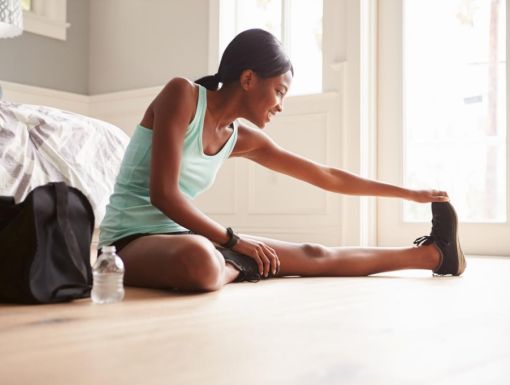
Common Running Injuries: 10 Stretches to Help You Heal
It’s no surprise that exercise is good for the body, and running is an easy, accessible way for most people to get moving. Not only is running a great cardio workout that keeps your heart and lungs strong, it also helps build muscle, increase strength and endurance and bulk up your bone density. With all those endorphins swirling around, getting that run in can even help reduce stress and boost your mood.
Sounds too good to be true, right? It doesn’t have to be. While it is fairly common to incur an injury from running, oftentimes a simple fix is all it takes: Stretching, adjusting your body mechanics or changing up the intensity of your regimen can all help you get back to the track. Let’s take a look at the top three running injuries and what you can do if you’re face-to-face with one.
What is runner’s knee?
There is a common belief that running is bad for your knees. We hear it all the time in physical therapy practice, and many people believe running causes arthritis in the knees. What does the science say? No. A recent study showed regular running can actually help protect the knees from arthritis.
If it’s not arthritis, then why do my knees hurt? Non-arthritic knee pain is very common in runners. In fact, the most common running injury is patellofemoral pain syndrome, also known as “runner’s knee.”
Runner’s knee is an overuse injury that is often described as a deep pain in the front of the knee (near the kneecap) that is caused by repetitive motions like running. Those with runner’s knee may also experience pain during activities like squatting, walking up and down stairs and even sitting for long periods of time.
Runner’s knee can be caused by several factors, but is often preceded by changes in athletic training volume or intensity. Impaired movement patterns can also lead to more stress on the knee, these may include:
- Weakness in the thigh muscles (quadriceps)
- Weakness in the hip and core muscles
- Tightness around the kneecap
- Tightness in hamstrings, quadriceps and calf muscles
- Excessive mobility of the kneecap (patella)
- Poor running mechanics, such as overstriding or valgus collapse (knock-knees)
What can I do if I start to experience runner’s knee?
If you start to notice a new pain in your knee, consider scaling back on your running for a couple of days. While most running injuries are unlikely to cause long-term damage, cutting back your mileage can help to bring the pain level down.
A good next step is to evaluate your last couple of weeks of training. Have you made any significant changes to your regimen? If so, you may just need to scale back on the change and build back up more slowly.
If your knee pain continues after making mileage or intensity adjustments, try these easy exercises and changes to running mechanics to help with symptoms:
- Dynamic warmup: components should include 5 minutes of walking/light jogging, a short exercise program to activate the leg/hip/core muscles (forward and sideways lunges aregreat examples), and exercises to lightly stretch the muscles (5 second holds).
- Stretch: Perform long-duration static stretches AFTER running, targeting your hamstrings, quad muscles, and calf muscles.
- Add other types of exercise: Add regular strength training and core exercise into your exercise program. 2-3 times per week for 15-30 minutes is a great starting point. Focus on strengthening the muscles of core, hips, and thighs (quads and hamstrings).
- Increase your cadence: Cadence is your step rate, or the number of steps you run/walk per minute. Boosting the number of steps can help alleviate some of the issues that put more stress at the knee. A good way to measure cadence and stick to your pacing is to use a metronome app while you run. Shoot for 170-180 steps per minute.
What causes heel pain?
Achilles tendinitis is a common running injury with symptoms including localized pain during exercise or activity, and swelling and stiffness around the heel after periods of rest. One of the most common risk factors for developing Achilles tendinitis is training errors such as increasing your weekly mileage too much. Other common risk factors include ankle stiffness and calf weakness.
What can I do to help my Achilles tendinitis?
One of the best treatment approaches is eccentric exercise — exercise focused on lengthening the muscles by slowly contracting them. Eccentric muscle contractions reload the tendon to help it heal and function correctly.
If you’re dealing with Achilles tendinitis, try these exercises to start your road to recovery. Before beginning, be sure you are not experiencing intense pain, tenderness or swelling around your heel.
- Eccentric Heel Raise: with both feet flat on the floor, stand up onto your tip-toes. While keeping the knees straight, lift the good heel from the floor, and slowly lower the bad heel back down to the floor. Repeat for 3 sets of 15 repetitions. Expect mild to moderate discomfort with this exercise. Progress this exercise by standing on a step with your heels hanging off the edge and performing the exercise mentioned above.
- Self-Massage to Calf: locate tender spots within the calf. While applying tolerable pressure to the sore spot with your fingers or a tennis ball, move your ankle up and down (to your head and the floor). Continue until the tenderness or soreness resolves. You may perform this in multiple areas if desired.
- Ankle Self-Mobilization: get into a half-kneeling position with the injured leg forward and kneeling on the good leg (use padding if needed). Using an anchored resistance band or the webspace of your hand on the front of your ankle, lunge forward on the bad leg while keeping your heel flat on the floor. Hold this position for 3 to 5 seconds and then return to the starting position. Repeat for 3 to 5 minutes.
Running with a hamstring injury
The hamstring muscle group is crucial for a healthy runner: The hamstrings play a key role in increasing stride length, improving cadence and maintaining your intended pace throughout a race.
The basic function of the hamstring muscle group is to slow the leg down before foot contact with the ground and to straighten the leg during push-off — two vital movements needed for efficient running. It’s important to consider including a dynamic warm-up during training to prime your body and specific muscles for the imposed demand that will follow. When this critical step is overlooked, it can lead to hamstring injury.
Hamstring injuries are common in activities that involve running, changing direction and lifting objects from the ground. Depending on the severity, a hamstring injury can cause a significant loss of time from training or competition.
What should I do if I injure my hamstring?
One of the hallmark signs of a mild hamstring injury is sudden, sharp pain in the back of the thigh. If the hamstrings are weak, undertrained or overused, a runner can feel a deep cramping sensation in the back of the thigh, indicating the need for specific exercise interventions.
Signs of a more serious hamstring injury are the feeling of a mass or sunken in area and/or bruising in the back of the thigh. If you experience the latter, seeking treatment or consultation from a sports medicine physician or physical therapist may be appropriate.
To help ease symptoms of a hamstring injury and to help prevent future injuries, incorporate these exercises into your regular workout:
- 90/90 Slider: This exercise is important to restore the mobility of the hamstrings and the sciatic nerve the passes through the muscles of the back of the thigh.
- Setup: Begin lying on your back with your knees bent and feet flat on the floor. Grasp one leg behind your thigh and straighten that knee until you feel a sensation of moderate stretch.
- Movement: Bend your foot down toward your body, then away toward the ceiling, keeping your leg as straight as possible throughout the movement. Repeat this movement for 10-15 repetitions. Complete 2-3 rounds of 10-15 repetitions.
- Tip: Make sure to keep your low back flat on the floor by bracing the core muscles during the exercise.
- Bridges with Leg Walk Out: This exercise is important to strengthen the muscles of the buttock along with the hamstrings as they need to work together for optimal performance.
- Setup: Begin by lying on your back with your hips and knees bent and feet flat on the floor.
- Movement: Begin by bracing the core muscles. Then, lift your hips off the ground into a bridge position, then slowly walk your heels away from your body one a time until your knees are nearly straight. Then, return to the starting position. Repeat for 10-12 repetitions. Complete 2-3 rounds of 10-12 repetitions.
- Tip: Make sure to keep your abdominals tight and do not let your hips drop to either side as you move your legs.
- Single Leg Russian Deadlift: This exercise is important for strengthening the hip muscles and to promote stability in a single leg stance; a vital component of distance running.
- Setup: Begin in a standing upright position holding a kettlebell/dumbbell in one hand.
- Movement: Lift one leg off the ground and bend forward at your hips as if you are bowing, lowering the kettlebell toward the planted foot. Then return to an upright position and repeat. Repeat 8-10 repetitions with a moderate weight with emphasis on slow, controlled movement. Complete 2-3 rounds of 8-10 repetitions.
- Tip: Make sure to keep your back straight during the exercise and have a slightly bent but sturdy knee in the stance leg as you bow forward and return to an upright position.
Once your movement issues are addressed and pain subsides, follow the 10% rule when getting back into running: Increase mileage by 10% per week. Intensity can gradually be added back in also, but it’s best to get your mileage base up before adding intensity. Also consider that it may take six weeks for some symptoms to resolve after a running injury.
If you continue to have pain even after working on training issues, strength and flexibility, consider scheduling a visit to your trusted physical therapist or sports medicine provider. They will be able to break down your strength, mobility, and general movement patterns to develop a specific treatment program for you.
Need help training for your next big race? Call 504-842-4348 to schedule an appointment with a sports physical therapist.



